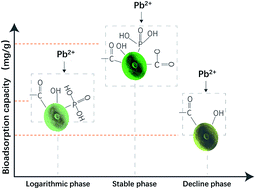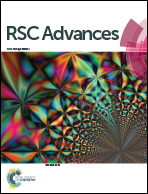Algal biomass from the stable growth phase as a potential biosorbent for Pb(ii) removal from water
Abstract
In this study, the effect of the growth phase on the Pb(II) removal performance from water using Chlorella sp. QB-102 dry biomass was investigated. Optimum biosorption conditions were determined as a function of initial solution pH and contact time. Freundlich isotherm and pseudo-second-order kinetics models were found to be most applicable to Pb(II) adsorption on biomass from each growth phase. The maximum adsorption capacities of Pb(II) were found to be 205.5, 298.5 and 171.9 mg g−1 for logarithmic, stable and decline phases of biosorbents, respectively. The FT-IR, XPS and potentiometric titration results showed that the lack of phosphoryl groups caused the lowest adsorption efficiency for the decline phase, and the more effective active sites in carboxyl and higher site concentrations of hydroxyl and phosphoryl functional groups led to most of the bioadsorption occurring during the stable phase. Thus, algal biomass from the stable phase can be used as a potential adsorbent for heavy metal removal from water.



 Please wait while we load your content...
Please wait while we load your content...